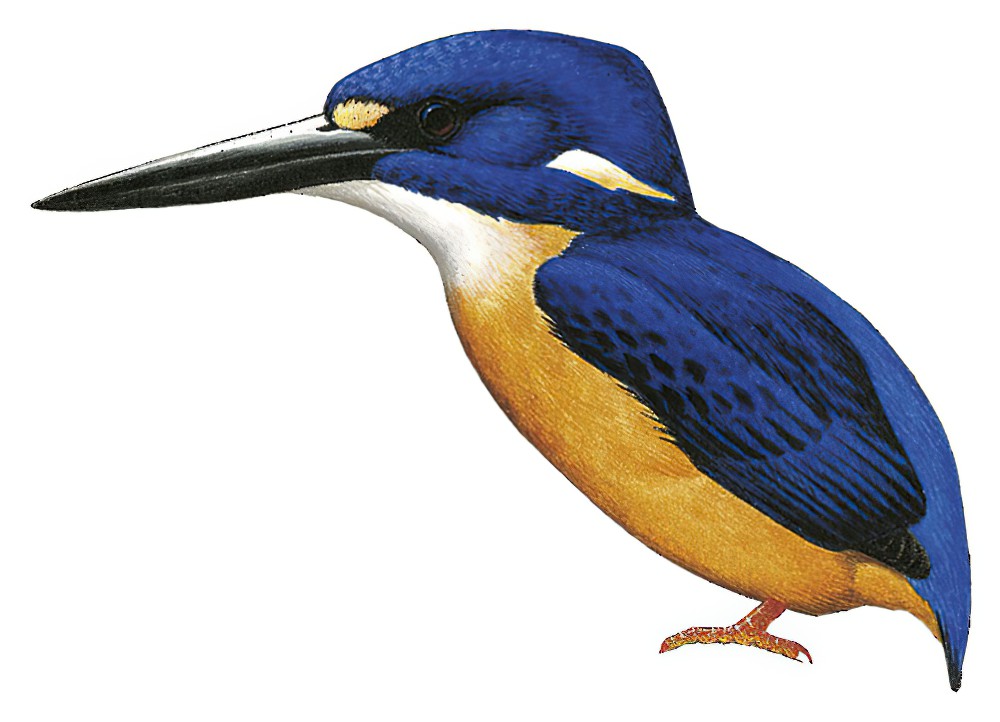Papuan Dwarf-Kingfisher / Ceyx solitarius

Papuan Dwarf-Kingfisher
SCI Name:
Protonym: Ceyx solitaria Pl.Col. livr.100 pl.595 fig.2
Taxonomy: Coraciiformes / Alcedinidae / Ceyx
Taxonomy Code: vardwk6
Type Locality: Lobo Bay, New Guinea.
Author: Temminck
Publish Year: 1836
IUCN Status: Least Concern
DEFINITIONS
CEYX
(Alcedinidae; Ϯ Oriental Dwarf Kingfisher C. erithaca) L. ceyx, ceycis seabird variously identified < Gr. κηυξ kēux, κηυκος kēukos seabird mentioned by Dionysius and Lucian, and considered identical to the halcyon. In Gr. myth. Ceyx, blasphemous husband to Alcyone, was drowned at sea and metamorphosed into a kingfisher along with his desolated wife when she found his body washed up on the shore; "62. CÉYX. Ceyx. { Le bec très-long; la langue courte; le tarse très-court; chaque pied ne présentant que trois doigts." (de Lacépède 1799); "Ceyx Lacépède, Tabl. Ois., 1799, p. 10. Type, by monotypy, Alcedo tridactyla Pallas = Alcedo erithaca Linné (species added, Daudin, in Buffon, Hist. Nat. (éd Didot), 14, 1802, p. 287.)" (Peters, 1945, V, p. 178).
Var. Ceix, Ceux, Ceycis.
Synon. Alcyon, Argyroceyx, Ceycalcyon, Ceycopsis, Cyanoceyx, Micralcyone, Therosa.
solitaria / solitaris / solitarius
L. solitarius solitary < solus, solius alone.
● According to Fraser in P. Sclater 1859a, the Solitary Shrike Tyrant was called “el Solitario” by the Spanish settlers of Ecuador (Agriornis).
● ex “Coucou Solitaire” of Levaillant 1806, pl. 206 (Cuculus).
● ex “Green-headed Bunting” of Latham 1785 (syn. Emberiza hortulana).
● “Solitary Sparrow ... It is wont to sit alone on the tops of ancient Edifices and Roofs of Churches, singing most sweetly, especially in the Morning, whence it took its name” (Ray 1678); "95. TURDUS. ... solitarius. 14. T. cæruleus, remigibus rectricibusque nigris, abdomine lineolis cinereis undulato. Passer solitarius. Willugb. orn. 191. Raj. av. 66. Edw. av. 18. t. 18. Olin. av. 14. Act. Ups. 1750. p. 21. Habitat in Oriente. Mas cæruleus; Femina cinerea, subtus lineolis albis & cinereis undulata." (Linnaeus 1758) (Monticola).
● (Statius Müller 1776) ex “Merle solitaire de Manille” of d’Aubenton 1765-1781, pl. 564, fig. 2 (syn. Monticola solitarius philippensis).
● (J. Gmelin 1789) ex “Passera solitaria” of Olina 1622, “Solitary Sparrow” of Willughby 1676, “Passer solitarius” of Ray 1713, “Merula solitaria” of Brisson 1760, “Merle solitaire” of de Buffon 1770-1783, and “Solitary Thrush” of Latham 1783 (syn. Monticola solitarius).
● ex “Suirirí chorreado todo” of de Azara 1802-1805, no. 196 (Myiodynastes).
● ex “Solitaire” of Leguat 1708, and de Buffon 1770-1783, and “Solitary Dodo” of Latham 1785: “not met with in flocks, scarcely more than two being found together” (‡Pezophaps).
● ex “Solitary Parrot” of Latham 1787 (Phigys).
● ex “Japú negro” of de Azara 1802-1805, no. 58 (Procacicus).
● ex “Oiseau Solitaire” of Carré 1669, and “Solitaire” of Dubois 1674 (this bird was formerly thought to be a species of dodo Raphus) (‡Threskiornis).
● ex “Ynambú Mocoicogoé” of de Azara 1802-1805, no. 332 (Tinamus).
● "This new species inhabits the watery solitudes of our highest mountains during the summer, from Kentucky to New York" (A. Wilson 1813) (Tringa).
UPPERCASE: current genus
Uppercase first letter: generic synonym
● and ● See: generic homonyms
lowercase: species and subspecies
●: early names, variants, mispellings
‡: extinct
†: type species
Gr.: ancient Greek
L.: Latin
<: derived from
syn: synonym of
/: separates historical and modern geographic names
ex: based on
TL: type locality
OD: original diagnosis (genus) or original description (species)












